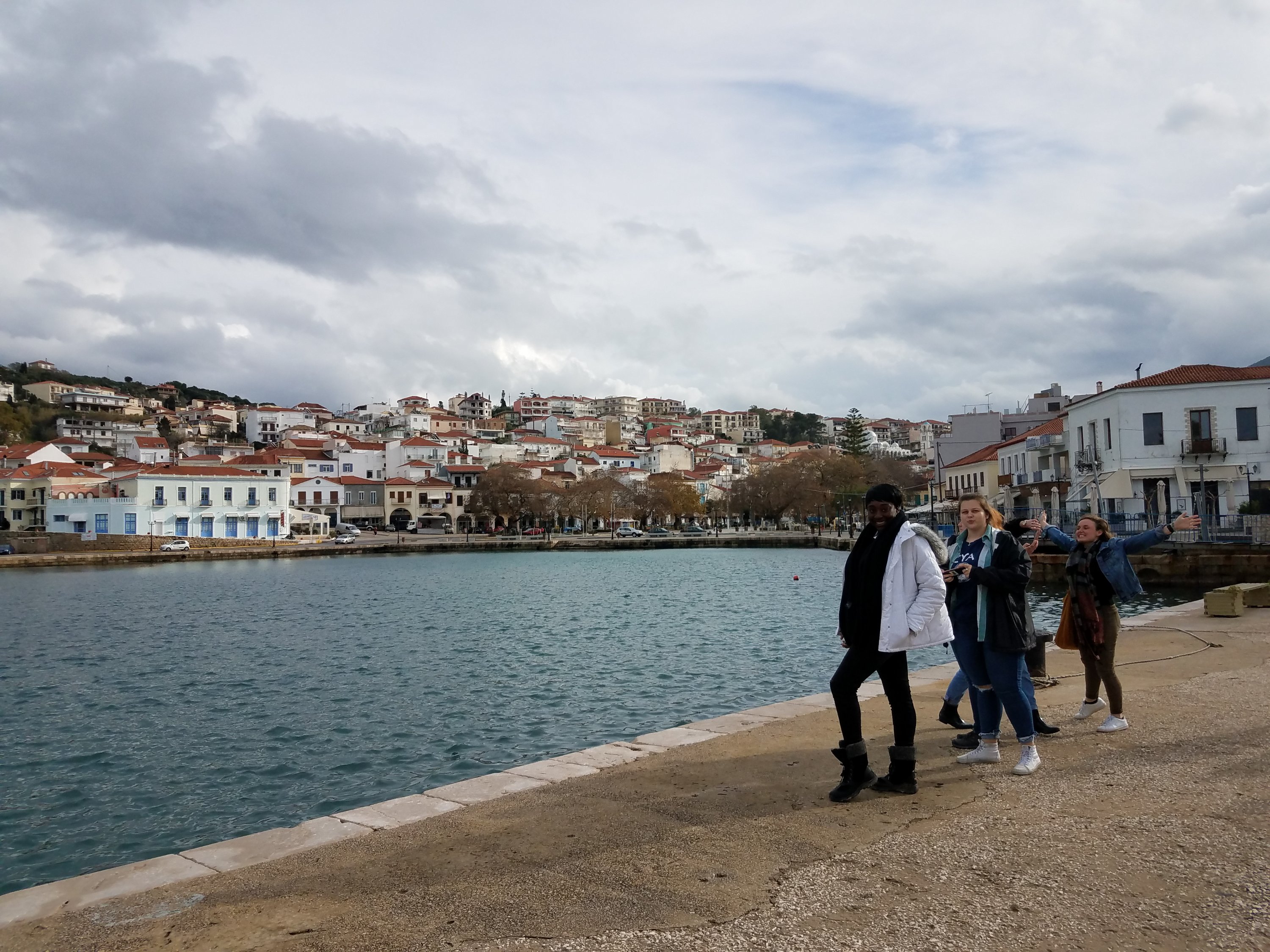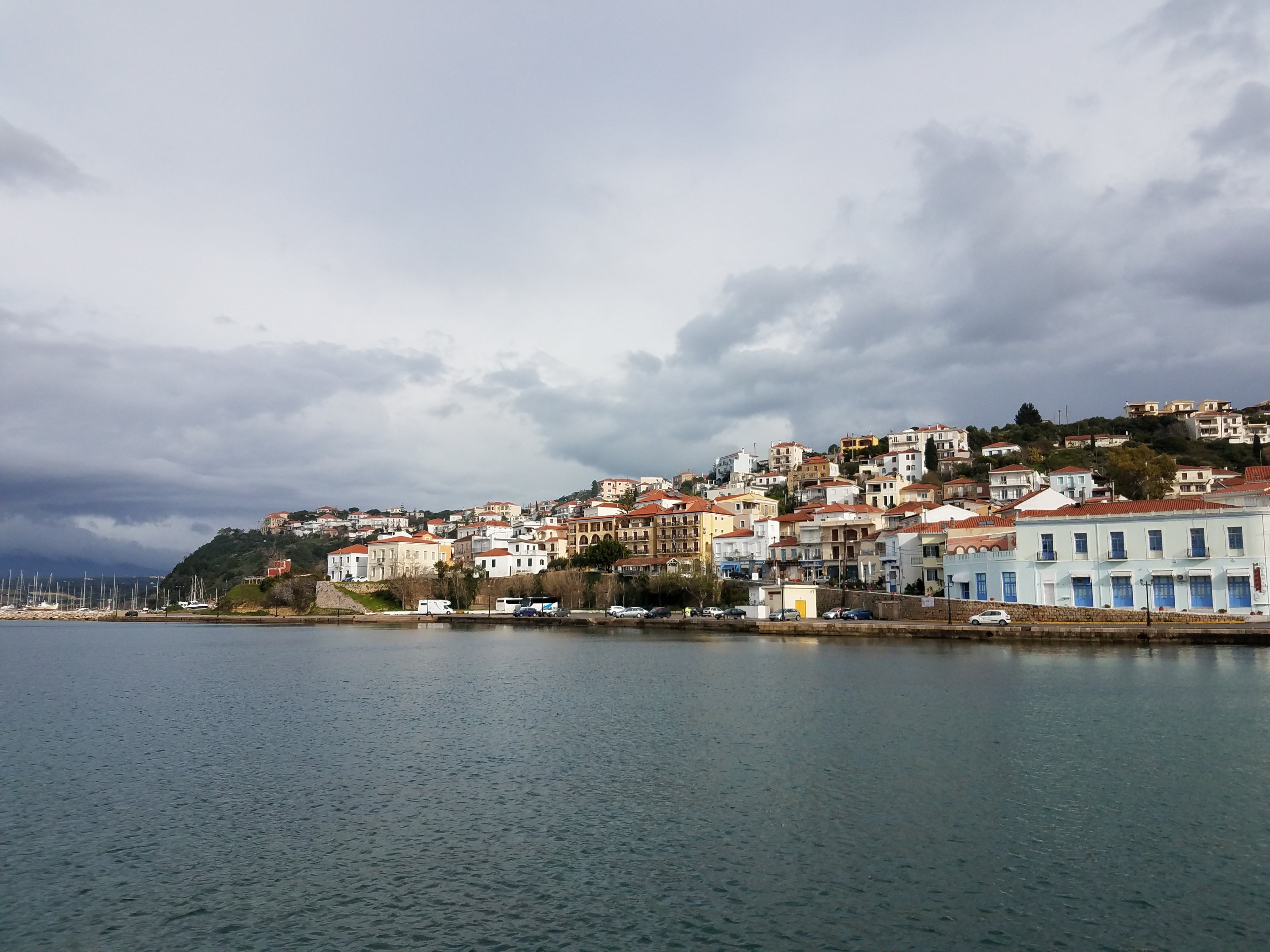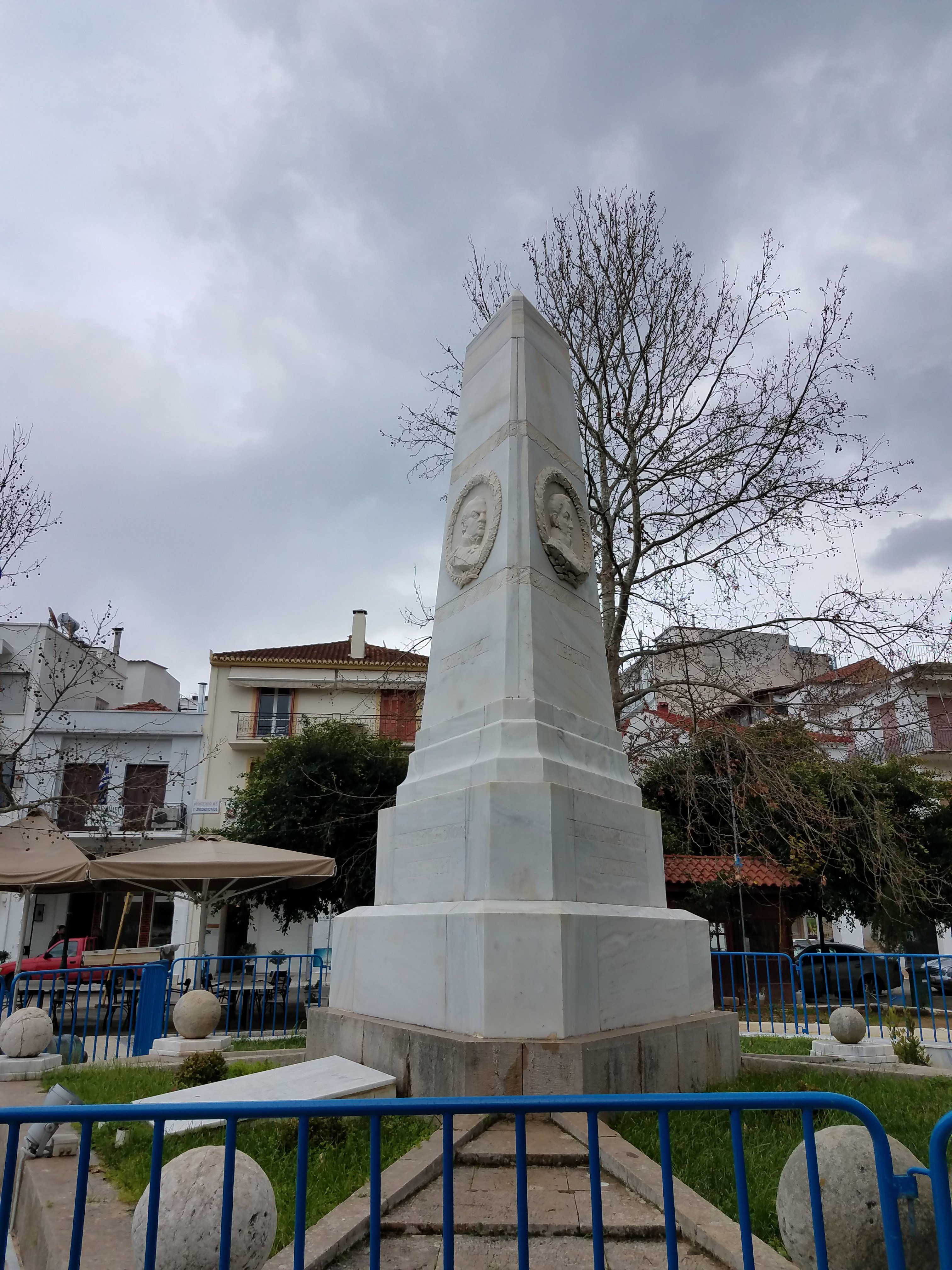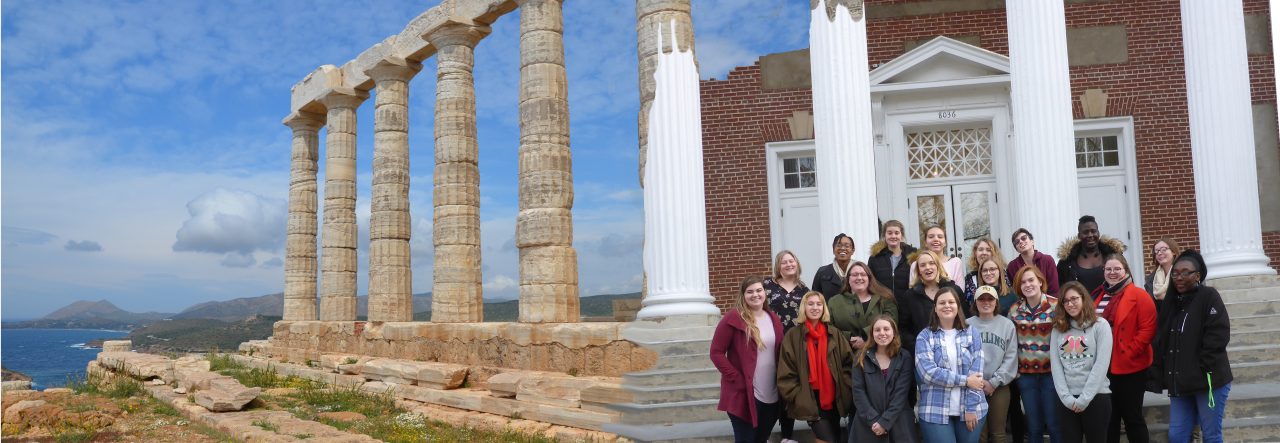By Faith Herrington and Valerie Sargeant
We began our day with an early start, as we left the seaside town of Kyparssissia and headed to the ancient site of Pylos. Despite the rain everyone was in good spirits as we headed to explore a new site. Lucky for us the “Palace of Nestor” an ancient Mycenaean administrative building that sits in a prime location on top of a hill, is a covered site so everyone stayed nice and dry. We had the chance to learn about the architecture and history of the structure, with its central megaron and muiltipe story design it was incredibly architecturally advanced. We also learned about how the destruction of the palace was purposeful and that they used the olive oil store rooms to fule the fire and destruction of the complex. Although we are unsure of the reason for the collapse of the Mycanean civilization it was probably due to the culmination of events including: invading sea peoples, civil unrest, drought, and famine.

 There was also an education center on the site that allowed us to explore what the rooms at Nestor would have felt like in antiquity which was very interesting. In the exhibit we discussed more about archeological excavation processes and how they have changed throughout the years to try to protect the artifacts. We walked to the Tholos tomb which was just a few meters away from the site of the palace. This beehive shaped tomb was raided in antiquity but serves as a good representation of Tholos tombs that were commonly used by the Mycenaean people. Despite the muddy ground we were able to explore the structure and a near by active dig site of a shaft grave. Which really gave us a good idea of how modern day excavations are run.
There was also an education center on the site that allowed us to explore what the rooms at Nestor would have felt like in antiquity which was very interesting. In the exhibit we discussed more about archeological excavation processes and how they have changed throughout the years to try to protect the artifacts. We walked to the Tholos tomb which was just a few meters away from the site of the palace. This beehive shaped tomb was raided in antiquity but serves as a good representation of Tholos tombs that were commonly used by the Mycenaean people. Despite the muddy ground we were able to explore the structure and a near by active dig site of a shaft grave. Which really gave us a good idea of how modern day excavations are run.

 After visiting the Tholos tomb and shaft grave we went to the nearby museum of Pylos which had items that were excavated from the palace of Nestor and other nearby Mycenaean sites. The museum used the pattern of the megaron in its rooms and in the floor in order to echo the site that the objects came from. It was a small museum but had a great collection of very significant objects including Linear B tablets and large Mycenaean storage vessels. We had an excellent presentation from Elizabeth Lauderdale on Linear B, the language the Mycenaeans used to record administrative information. Elizabeth gave us worksheets so we could figure out how to write our names in Linear B which was a fun interactive way to learn about the script. We continued to walk through the museum and explore the collection of pottery and wall paintings until we had to leave.
After visiting the Tholos tomb and shaft grave we went to the nearby museum of Pylos which had items that were excavated from the palace of Nestor and other nearby Mycenaean sites. The museum used the pattern of the megaron in its rooms and in the floor in order to echo the site that the objects came from. It was a small museum but had a great collection of very significant objects including Linear B tablets and large Mycenaean storage vessels. We had an excellent presentation from Elizabeth Lauderdale on Linear B, the language the Mycenaeans used to record administrative information. Elizabeth gave us worksheets so we could figure out how to write our names in Linear B which was a fun interactive way to learn about the script. We continued to walk through the museum and explore the collection of pottery and wall paintings until we had to leave.
 We drove to the modern city of Pylos where we will spend the night. It a cute city on the bay of Navarinon.
We drove to the modern city of Pylos where we will spend the night. It a cute city on the bay of Navarinon.

 After having some time for lunch we regrouped to learn about some of the significant battles that have occurred in the bay of Navarinon. Professor Richter told the story of the battle during the Greek war of independence between the British, French and Russians and the ottomans. In which the British forces defeated the ottomans and helped Greece win independence. We also learned about the battle of Sphacteria during the Peloponnesian war in 425 BCE in which the Spartans were defeated by the Athenians. After visiting the Tholos tomb and shaft grave we went to the nearby museum of Pylos which had items that were excavated from the palace of Nestor and other nearby Mycenaean sites. The museum used the pattern of the megaron in its rooms and in the floor in order to echo the site that the objects came from. It was a small museum but had a great collection of very significant objects including Linear B tablets and large Mycenaean storage vessels. We had an excellent presentation from Elizabeth Lauderdale on Linear B, the language the Mycenaeans used to record administrative information. Elizabeth gave us worksheets so we could figure out how to write our names in Linear B which was a fun interactive way to learn about the script. We continued to walk through the museum and explore the collection of pottery and wall paintings until we had to leave. We drove to the modern city of Pylos where we will spend the night. It a cute city on the bay of Navarinon. After having some time for lunch we regrouped to learn about some of the significant battles that have occurred in the bay of Navarinon. Professor richter told the story of the battle during the Greek war of independence between the British, French and Russians and the ottomans. In which the British forces defeated the ottomans and helped Greece win independence. We also learned about the battle of Sphacteria during the Peloponnesian war in 425 BCE in which the Spartans were defeated by the Athenians. After the discussion we walked to a local cafe and reflected on the time we have spent in Greece so far. We look forward to visiting Sparta tomorrow and are grateful for the wonderful time we had in Pylos.
After having some time for lunch we regrouped to learn about some of the significant battles that have occurred in the bay of Navarinon. Professor Richter told the story of the battle during the Greek war of independence between the British, French and Russians and the ottomans. In which the British forces defeated the ottomans and helped Greece win independence. We also learned about the battle of Sphacteria during the Peloponnesian war in 425 BCE in which the Spartans were defeated by the Athenians. After visiting the Tholos tomb and shaft grave we went to the nearby museum of Pylos which had items that were excavated from the palace of Nestor and other nearby Mycenaean sites. The museum used the pattern of the megaron in its rooms and in the floor in order to echo the site that the objects came from. It was a small museum but had a great collection of very significant objects including Linear B tablets and large Mycenaean storage vessels. We had an excellent presentation from Elizabeth Lauderdale on Linear B, the language the Mycenaeans used to record administrative information. Elizabeth gave us worksheets so we could figure out how to write our names in Linear B which was a fun interactive way to learn about the script. We continued to walk through the museum and explore the collection of pottery and wall paintings until we had to leave. We drove to the modern city of Pylos where we will spend the night. It a cute city on the bay of Navarinon. After having some time for lunch we regrouped to learn about some of the significant battles that have occurred in the bay of Navarinon. Professor richter told the story of the battle during the Greek war of independence between the British, French and Russians and the ottomans. In which the British forces defeated the ottomans and helped Greece win independence. We also learned about the battle of Sphacteria during the Peloponnesian war in 425 BCE in which the Spartans were defeated by the Athenians. After the discussion we walked to a local cafe and reflected on the time we have spent in Greece so far. We look forward to visiting Sparta tomorrow and are grateful for the wonderful time we had in Pylos.



May I just say what a relief to find an individual who genuinely knows what they’re discussing on the web.
You definitely understand how to bring a problem to light and
make it important. More people ought to read this and understand this side of your
story. I was surprised that you’re not more popular because you certainly have the gift.
LikeLike
Hi, everything is going fine here and ofcourse every one is sharing facts, that’s genuinely
fine, keep up writing.
LikeLike